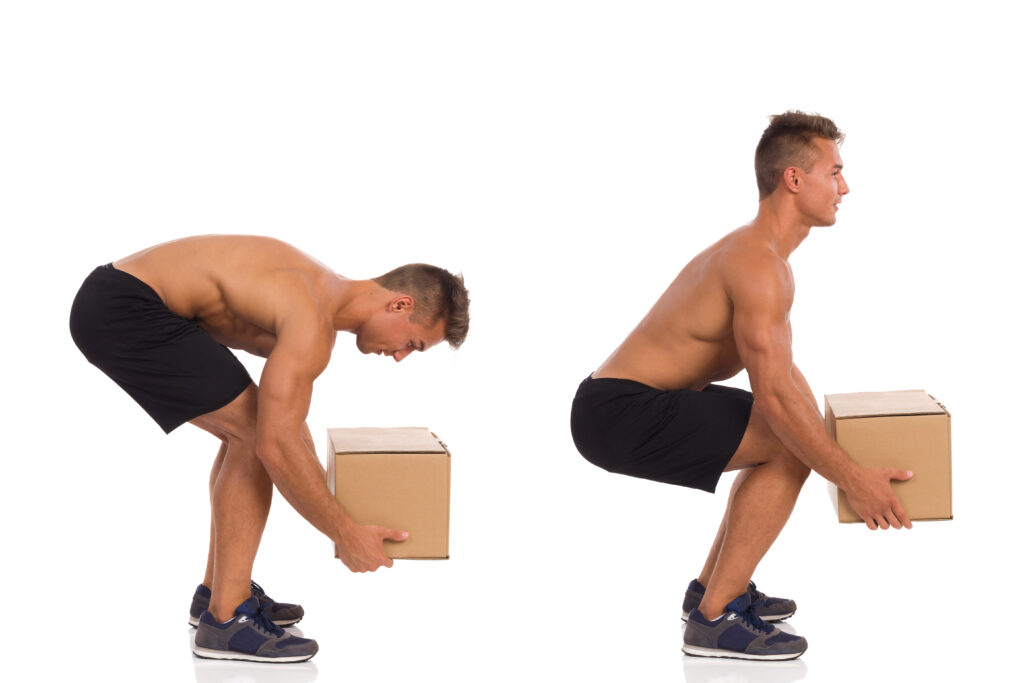
Technique
Date: 17/01/2023Key points
- There are certain “rules” to decribe what is correct technique and not
- Many believe that if they don’t use “correct technique”, they risk injuring them selves.
- But your whole life is full of situations with “wrong technique”, so why aren’t we all injured all the time?
- There is no such thing as “wrong technique”, you should in fact try to use all of your bodys possible movements to stay flexible and pain free
- Sometimes it’s beneficial to give instructions in correct technique, but that has very little to do with injury and more to do with effect.
Introduction
Starting to exercise can be confusing. There are a lot of rules as to how you should be exercising. Some of those “rules” might lead you to think that you can do something “wrong” and injur your self. Rigid rules like “Knees over toes, keep a straight back” might feel intimidating for anyone new to all this. It can seem like there is only one correct technique when doing an exercise, and everything else is dangerous. Unfortunately, these cues for what is correct and what is incorrect technique might scare people from exercising. What happens if you use the “wrong” technique? Can you injur you self?
You’ve probably heard some of them already. “Knees over toes” or you’ll overload the muscles and tendons in your knee! “Keep a straight back” or you’ll herniate a disc in your back!
These types of instructions can be frightening. I bet you probably want to exercise with proper technique to become strong rather than to do it wrong and get a serious injury. But how much truth is there in statements like these? What happens to people who don’t follow these “rules”? Hint; there are lots of examples of people who intentionally exercises with a bent back or knees far beyond toes who are strong, healthy and injury free.
You’re not made of porcelaine
Fortunately for us, the body doesn’t live by these “rules”. There is a reason that your back can bend and move in all sorts of ways. If you exclusively move your back within a limited range of movement to protect it, you remove any possibility for the back to become strong outside of those limited movements. “Use it or loose it”. If you chose to exclude some movements because you’re afraid it’ll hurt you, you’ll end up being weak in that movement. Don’t be afraid to bend your back, it likes to be moved in all sorts of directions!

We’re all built differently
And – everyone is built a little different. We all have different natural curves in our backs. Some might have a very sway back. Others have a completely flat back. And you’ll also find people with an S-shaped back. To claim that all these people should be exercising with the identical technique when they all have a unique body, is a little strange. Isn’t it?
How’s your “technique” in every day movements?
And your knees. Imagine if your knees were to be overloaded everytimes you “loaded them incorrectly”. Everytime you didn’t think “knees over toes” while decending stairs. Or they weren’t correctly aligned when you picked up your child from the floor? There are loads of situations in your every day life where you’re knees would be injured if there really was something called “incorrect technique”.
What does “Knees over toes” actually mean? It means that you need to avoid pushing your kneed further forwards then your toes when you squat down. Your knees are preferably to never pass a straight line from your toes. Some say that pushing your knees forwards can place too big of a load on your knees and injure them. But there are rehabilitation exercises for the knees where you’re supposed to push your knees past the “toe-line”. Those exercises are ment to strengthen the tendons and muscles in the knee to withstand more load. Wouldn’t it be strange if a rehabilitation exercise could hurt your knees?
But how come some people get injured by exercise then?
Your body is made strong and steardy. You won’t injure your self by using it within a range of movement that is completely natural for it. If nature has made it so your back can bend, why would you injure your self by bending it? By allowing your self to move your body within all the different ranges of movement it has, it becomes stronger and more flexible in all those movements. If you keep avoiding to bend your back, your back will never become stronger in a bendt position. The ranges of movements you don’t use, you lose. What happens the day you have to bend your back to pick something up? Well, there is a possibility that you might hurt your self because you load the back in a position it’s not used to. The load easily becomes an overload.

Exercising with a bent back or with knees over toes isn’t going to cause an injury. What’s important is how you get progression. Your body needs time to slowly adapt to new loads. Going from not exercising at all to suddenly exercising 4-5 times a week can be a bit of a shock for the body. Going from very little exercise to forcing progress every time you exercise is also a recipe for injury.
Most people injur them selves exercising because they do “too much too fast”, not because of incorrect technique. People tend to forget that your muscles and tendons actually needs time to build stronger and withstand more load. People want results and quick fixes, but the key is patience and building step by step. Make sure you do challenge your self a little, so you’re stronger in a month than you are today. But don’t expect progress in every work out.
Then why does Trigo give specific instructions to technique?
Trigo has added instructions for all our activities. You’ll find things like “keep a straight back” and “knees over toes” oin our app as well. How come we do that, if technique isn’t really that important?

All of our routines and programmes are made with a specific intent. To help you build a stronger back, loosen up in your hips, rehabilitate from an injury. Sometimes, the intent of the activity and the routine can make it appropriate to recommend a certain technique. Not because you’ll injure your self if you don’t do it “out way”. It’s because we might want you to acheieve a specific effect of that exercise or activate a specific muscle. By pushing the hip back and knees behind toes you active more of the muscles in the back of your body. That might be useful if you want to put focus on the hip muscles or glutes. Pushing the knees forwards beyond the toe-line increases activation of the muscles in the front of your knee. That can be beneficial if you want to strenghten the front of the knee.
Anything can be “correct”, it just depends on the pupose of the exercise. Doing it a little differently then what we recommend isn’t going to hurt you. It isn’t going to remove all effect of the exercise. It just might not be as effective. What is most important is how the activity feels for you, in your body. If something feels off, try doing it just a little differently. You body might be more happy with a little tweak of the technique. Adjust the activities as you need.
You might injure your self at some point, but not due to technique
Unfortunatly, not all painful conditons and injuries can be avoided. You won’t go through life pain free. Some will experience a disc herniation while exercising. It won’t be because of your technique. It probably would have happened later that week, when you unloaded the dishwasher or picked up some socks off the floor. Some of us are genetically predisposed. The stronger we are, the more protected our bodies are from injury. Yet, there is never a guarantee. What is certain is that not using your body at all and letting it become weaker will increase your injury risk dramatically. Fortunately, most painful conditions or injuries pass. In other words, you won’t have to live with a “broken knee” for the rest of your life. So let’s not be intimidated by all the “rules” people make. Let’s focus on becoming stronger and doing things that makes our bodies feel good!